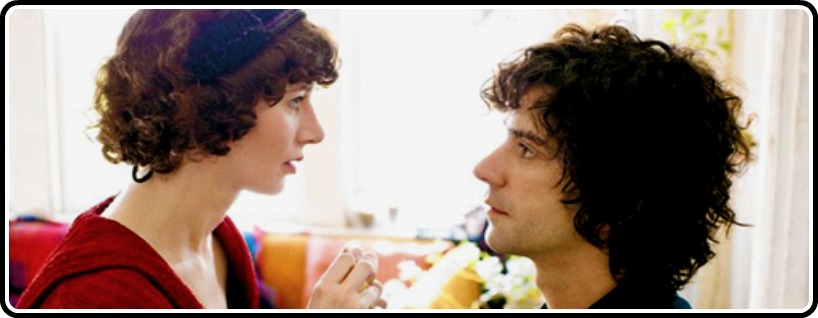Miranda July’s brand of storytelling works mainly in spurts. When her methods work, they resonate with an authenticity that rarely comes around in film, making a meaningful impact. When her ideas do not work the way they are meant to, moments and scenes feel simultaneously underworked and overworked. In these moments, the potential is great but the result feels hollow and decidedly inauthentic. In her 2005 debut Me and You and Everyone We Know, the former is more often the case. In her much anticipated follow-up The Future, there are ideas realized that will stun, but they are too often overshadowed by the inauthentic characters that surround the resonance.
Describing the plot of The Future will garner a strong and immediate response, either good or bad, by those who know nothing about the film. It is narrated by a terminally-ill cat named Paw-Paw (voiced by July), who is waiting for thirty-something couple Sophie (July) and Jason (Hamish Linklater, a real find) to pick her up from the adoption center. The cat narrates about the act of waiting and not waiting, being born and finally anticipating the dependence she will have on people who will love her. July narrates Paw-Paw as a barely-alive creature clinging onto the passing time as her last hope.
While Paw-Paw only appears intermittently, the film is otherwise entirely focused on Sophie and Jason. These two are nowhere near where they expected to be at their age. Sophie is a dance instructor for children and Jason does monotonous tech support. They use the impending arrival of Paw-Paw as an indicator representing their last chance at a worthwhile existence. The cat will need constant care because of her condition, so they look at the thirty days as the only time they can rebuild their lives.
Sophie does this by quitting her job and devoting her time to creating dance videos to post on YouTube. Jason quits his job and starts selling trees door-to-door. They both await their calling as Jason finds himself having an uncomfortably familiar connection with an old man who sells him a hairdryer for three dollars, while Sophie begins an illicit relationship with a man whose suburban life offers a mixed bag of potential consequences.
There is more to this story, as Jason literally stops time to take a moment which lasts longer than he means it to. This is a very ambitious project by artist/performance artist/author/actress/director Miranda July. Her ambition is absolutely essential to continuously invigorate the medium. There is a lot to admire, but the film does not quite work the way it should.
This is mainly because of the way July executes the idea or fear of not trying. Many of Sophie and Jason’s actions feel inauthentic and even absurd. What kind of person would quit their job and start to rebuild their life by dancing for YouTube? What kind of person randomly buys a three dollar hairdryer from someone when they are trying to build their life up? Sophie and Jason are clearly drifters; even the way they speak is listless and trance-like. The actions of the couple could have been convincing if the film had executed them somehow differently. It goes without saying that these characters are meant to be somewhat frustrating. Yet her depiction of the utter lack of motivation in people goes to such an extreme as to invalidate the effort, and the two main characters, to a significant degree. A setback of the otherwise fantastically drifting pace is that these off-putting developments have a much more detrimental effect than they otherwise might have.
There are flashes of genius here and when the film gets into its second half, it becomes metaphorically prominent and discards its orthodox plot, becoming a lot more interesting to watch. July does a dance entirely within a t-shirt that is brilliantly Lynchian in its surrealism. Jason’s connection with the old man had a very unique and meaningful effect on me. There is the moment of desperation in Jason saying that he needs a moment. There is a scene when Sophie sees the lives of her co-workers pass by within one conversation. Paw-Paw will be the official make-it of break-it moment for many, but her narration is sparsely poetic and beautiful if one allows themselves to just go with it.
The Future had a lot of potential which is especially understood through the moments mentioned above. It is unlike anything else out there and for that I fully applaud it. The vital worldview of this artist is unsupported by the way a few of her many ideas, mainly the commonly unused potential of man, are executed. The Future is uniquely evocative but is hard to care much about because of the two main characters and their misguided quest to find meaning in their lives.






![Bergman Island (The Criterion Collection) [Blu-ray]](https://criterioncast.com/wp-content/uploads/2022/11/bergman-island-the-criterion-collection-blu-ray-400x496.jpg)
![This Is Not a Burial, It’s a Resurrection (The Criterion Collection) [Blu-ray]](https://criterioncast.com/wp-content/uploads/2022/11/this-is-not-a-burial-its-a-resurrection-the-criterion-collection-blu-ray-400x496.jpg)
![Lars von Trier's Europe Trilogy (The Criterion Collection) [The Element of Crime/Epidemic/Europa] [Blu-ray]](https://criterioncast.com/wp-content/uploads/2022/11/lars-von-triers-europe-trilogy-the-criterion-collection-the-element-of-400x496.jpg)
![Imitation of Life (The Criterion Collection) [Blu-ray]](https://criterioncast.com/wp-content/uploads/2022/11/imitation-of-life-the-criterion-collection-blu-ray-400x496.jpg)
![The Adventures of Baron Munchausen (The Criterion Collection) [4K UHD]](https://criterioncast.com/wp-content/uploads/2022/11/the-adventures-of-baron-munchausen-the-criterion-collection-4k-uhd-400x496.jpg)
![Cooley High [Criterion Collection] [Blu-ray] [1975]](https://criterioncast.com/wp-content/uploads/2022/11/cooley-high-criterion-collection-blu-ray-1975-400x496.jpg)